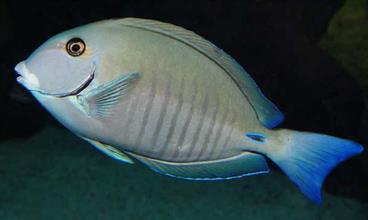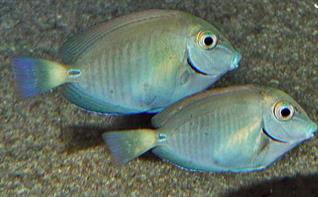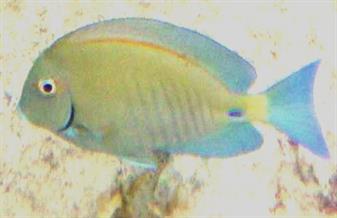



Acanthurus chirurgus
| Ecological Descriptors |
||||
| Habitat | Size (cm) | Diet | Behaviour | Sex |
| Co, R, | 35 | Veg (Cle) | Sh | F |
Description:
Adults: Body laterally compressed, oval in shape, with relatively long dorsal and anal fins and a crescent tail. Body bluish gray to dark brown, and pale or darken dramatically (Dark Phase). Body with 10 to 12 body bars, (Ocean Surgeonfish, A. bahianus never has bars) although they may be faint or even appear absent. Several markings radiate from the eye. Dorsal, anal and tail fins often with blue or white borders. Base of pectoral fin dark (cf. Ocean Surgeonfish which is clear), this is the only visual way to distinguish from Ocean Surgeonfish when it is not displaying bars.Base of tail with a dark sharp spine (like a surgeon's scalpel), sometimes with a white/ blue highlight behind the spine. Sometimes pale band on caudal peduncle. Pectoral fins often with dark leading edge.
Ecology
Inhabits shallow reefs or rocky areas, down to 25 m. Often in loose aggregations. Mainly diurnal.It grazes on many species of benthic algae, occasionally on seagrass. It also feeds on the film of algae on the surface of sand undisturbed by surge and also act as cleaners on fish and turtles.
The sharp spines at both sides of the base tail are used as defensive weapons by slashing their tails from side to side. When not in use, they are folded backwards against the body. In most locations fish settle inshore, grow to near full size and then, when 2 to 6 years old, relocate permanently to outer reefs.
Life Cycle:
Spawning occurs in the open ocean, typically around the evening time of the lunar cycle leaving behind fertilized eggs. At this time, the sea current is strongest and the tidal ranges are the largest. These groups consists of one male to one or more females.
Fertilization is external. Multiple eggs are laid, each consisting of an oil droplet enabling them to float, thus making them pelagic. Egg diameter <1mm, hatching within 24 hours into larvae which grow into the acronurus stage (a special stage found in tangs and surgeonfish ). They are commonly found close to the shore. No parental care.
Terminal size is reached at around age 4, and most of the growth occurred within the first 10% of the lifespan, and approximately 85% of full size is attained within the first year.
Adults: Body laterally compressed, oval in shape, with relatively long dorsal and anal fins and a crescent tail. Body bluish gray to dark brown, and pale or darken dramatically (Dark Phase). Body with 10 to 12 body bars, (Ocean Surgeonfish, A. bahianus never has bars) although they may be faint or even appear absent. Several markings radiate from the eye. Dorsal, anal and tail fins often with blue or white borders. Base of pectoral fin dark (cf. Ocean Surgeonfish which is clear), this is the only visual way to distinguish from Ocean Surgeonfish when it is not displaying bars.Base of tail with a dark sharp spine (like a surgeon's scalpel), sometimes with a white/ blue highlight behind the spine. Sometimes pale band on caudal peduncle. Pectoral fins often with dark leading edge.
Ecology
Inhabits shallow reefs or rocky areas, down to 25 m. Often in loose aggregations. Mainly diurnal.It grazes on many species of benthic algae, occasionally on seagrass. It also feeds on the film of algae on the surface of sand undisturbed by surge and also act as cleaners on fish and turtles.
The sharp spines at both sides of the base tail are used as defensive weapons by slashing their tails from side to side. When not in use, they are folded backwards against the body. In most locations fish settle inshore, grow to near full size and then, when 2 to 6 years old, relocate permanently to outer reefs.
Life Cycle:
Spawning occurs in the open ocean, typically around the evening time of the lunar cycle leaving behind fertilized eggs. At this time, the sea current is strongest and the tidal ranges are the largest. These groups consists of one male to one or more females.
Fertilization is external. Multiple eggs are laid, each consisting of an oil droplet enabling them to float, thus making them pelagic. Egg diameter <1mm, hatching within 24 hours into larvae which grow into the acronurus stage (a special stage found in tangs and surgeonfish ). They are commonly found close to the shore. No parental care.
Terminal size is reached at around age 4, and most of the growth occurred within the first 10% of the lifespan, and approximately 85% of full size is attained within the first year.
Doctorfish Juvenile

(C) Robertson & Van Tassell

(C) Ross Robertson
Doctorfish
Doctorfish


Doctorfish Dark Phase






304
508

Doctorfish


